- Home
- Encyclopedia
- A Territorial Empire: The Trabings and Their Fr...
A Territorial Empire: The Trabings and their Freight
Often we forget freighters and their important role in the early West. We read about cowboys, outlaws, mountain men and the rest but we have few freighter heroes. They hauled massive amounts of supplies to forts and soldiers, miners, settlers and Indian reservations using oxen, horses and mules. These bullwhackers, muleskinners and teamsters were hardy souls who provided what was needed to populate the West.
The Trabing Brothers, August and Charles, play a big part in this saga in Wyoming Territory. Born in Allendorf Hesse Cassel, Germany, they arrived in America in August 1853 with their blacksmith father. August was 11, Charles, 8. August wrote that the boys worked from that early age with their father in a wagon factory and learned the smithing trade as well. In June 1863, August went to Washington D. C. and enlisted with the U.S, Army’s Quartermaster Department, serving on guard duty at the Civil War forts around Washington D. C. and as a blacksmith until 1865.
On Aug. 28, 1865, both brothers departed for the West, working for the Army as blacksmiths and wagon repairers. They traveled with a quartermaster’s train of 258 six-mule-team government wagons headed to Fort McPherson near present-day North Platte, Neb., under Captain Gillis. This expedition, led by Col. Brown of the 12th Missouri, was to drive the Sioux and Cheyenne from the valley of the Republican River. During this time the Trabing brothers also acquired retail experience, ordering and dispensing at the sutler store. The campaigns lasted about five months.

With the mission complete, they were honorably discharged in spring 1866 and went into business two and one-half miles west of Fort McPherson at Box Elder canyon, where they had a blacksmith shop, boarding house, saloon and hotel. According to their records, they “…did a very profitable business and saved money.”
Although warriors ransacked and burned the store and ranch, the brothers rebuilt, according to August’s Indian depredation claim filed decades later with the federal government. On April 21, 1868 they were burned out a second time and some of their men were killed, including a cousin who worked for them. They suffered heavy losses in horses and cattle. Selling everything that was left, the brothers bought some condemned government horses and wagons and moved west to Laramie, Wyoming Territory.
Early days in Laramie
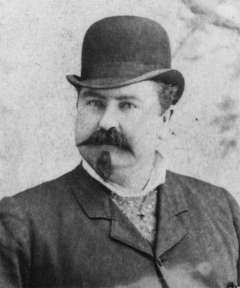
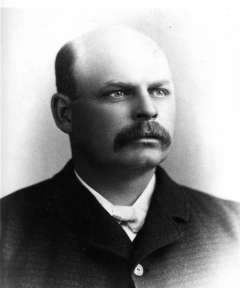 |
August, Ulrika—August’s first wife—and Charles arrived in Laramie on June 18, 1868, five weeks after the arrival of the transcontinental railroad. They soon met J. C. Walters and the three went into business. They began bidding for and getting freight contracts from Col. Benton of the Union Pacific Railroad to supply cord wood and ties for the UP at Cooper Lake Station west of Laramie and at Medicine Bow Station.
A Notice to Freighters in the Frontier Index on July 21, 1868, read: “The undersigned will employ 25 or more teams in hauling cord wood from the head of Cooper Creek to Cooper Lake Station-Union Pacific Railroad. For further information, apply to J. C. Walters or A. Trabing, Cooper Lake Station, 25 miles west of Laramie.” At Medicine Bow and Cooper Lake Station, they opened small stores, supplying whatever their freighters and tie cutters needed. Outlaws robbed them at Cooper Lake Station in 1869, and were soon captured and jailed by Albany County Sheriff Nathan K. Boswell.
On July 28 and 29, 1869, Ulrika and August Trabing bought vacant property and buildings on First Street in Laramie from W. B. Bent, land agent for the Union Pacific Railroad. This purchase included The National Theater which stood on parts of two lots. They ventured opening a saloon and theater for traveling vaudeville troupes coming in on the railroad. August was a singer and may have performed with some of the groups from time to time.
The building, refurbished and painted blue, became known as “The Old Blue Front—” a place that would figure in their story for the next 37 years. Ulrika would try running the business while August was filling the tie and wood contract at Cooper Lake but she wasn’t successful. Near this time coal was discovered at Carbon, Wyoming Territory, west of Medicine Bow. The railroad no longer needed cordwood, so the Trabings had to find other work. They decided to expand their Medicine Bow way station. They built a more substantial store and started a freighting business from there as well.
On Dec. 6, 1869, the Trabings leased their “Blue Front” building to their employee, George Weiske. In March 1870 their building would be sub-leased to Albany County as a temporary courthouse, since one had not yet been built. The Blue Front building served as the courtroom for the first jury in the world impaneling both men and women.
A store in Medicine Bow
In late December 1869 the Trabings left Laramie for Medicine Bow, on the railroad 60 miles to the northwest, with $35 worth of groceries—two wagons full—bought from Edward Ivinson. This began their mercantile and freighting career. At that time Medicine Bow had a freight depot and large quantities of military supplies were shipped in by train. From there they were freighted north to Fort Fetterman on the North Platte near present Douglas, Wyo., and later to other forts farther north. Troops were also stationed at Medicine Bow along with tie cutters and UP employees.
The road to Fort Fetterman ran 83.5 miles through the Laramie Mountains and was often closed by snow and flooding creeks in winter and spring. There were four hazardous river crossings. Floods often washed out bridges, making travel unpredictable. In 1874, weather and flooded crossings delayed freighting until July. That month, one newspaper noted the government had begun the season’s freighting to Fort Fetterman from Medicine Bow, and guessed that “Trabings are doing more business and making more money than any other house in the territory.”
By this time the Trabing businesses were growing steadily. They were freighting to Fort Fetterman using their own teams and men, operating a growing grocery store at Medicine Bow and remodeling part of their Laramie warehouse. Local newspapers published their store advertisements frequently. A March 26, 1875, Laramie newspaper describes their Medicine Bow operation “.. as one of the largest store-rooms with warehouses, corrals, stables, blacksmith-shop and emigrant houses attached to be found in Wyoming Territory. Sales last year exceeded $50,000,” or more than $1.1 million in today’s dollars.
The Trabing Brothers continued expanding, buying a ranch 17 miles north of Medicine Bow on Shirley Rim. This cattle operation became the TB Ranch.
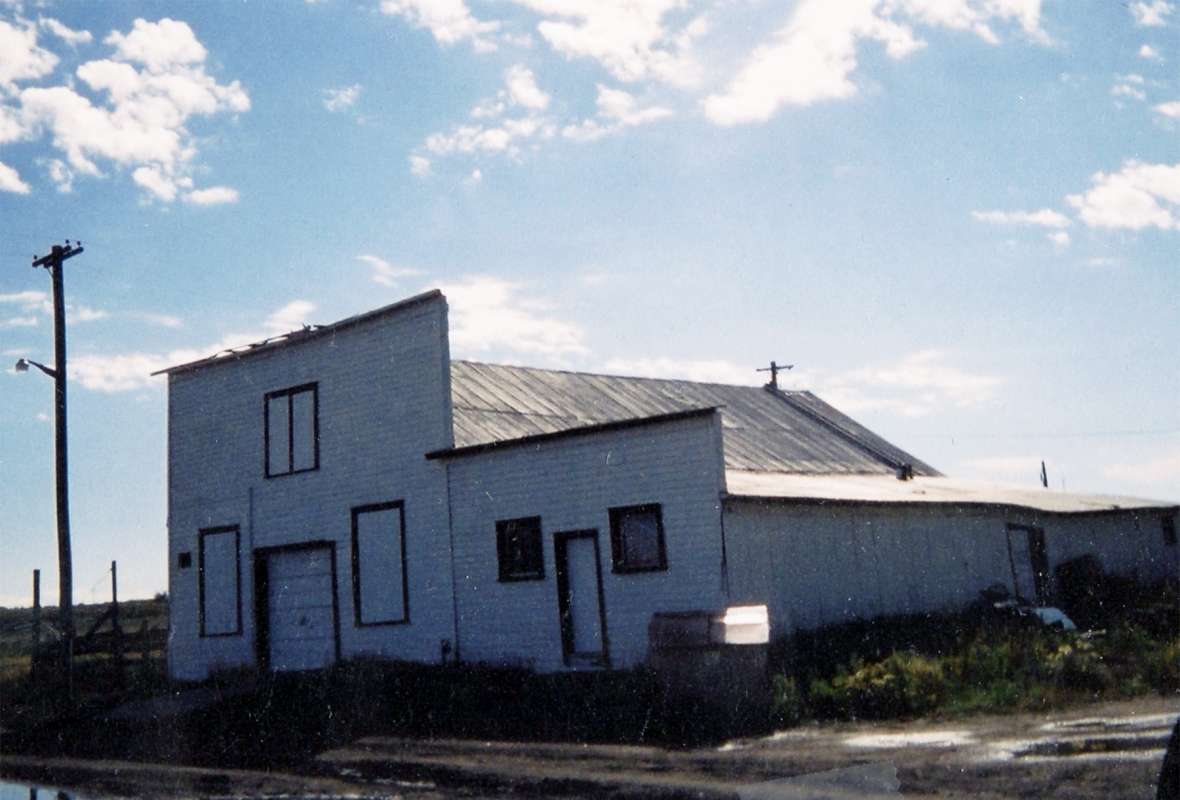
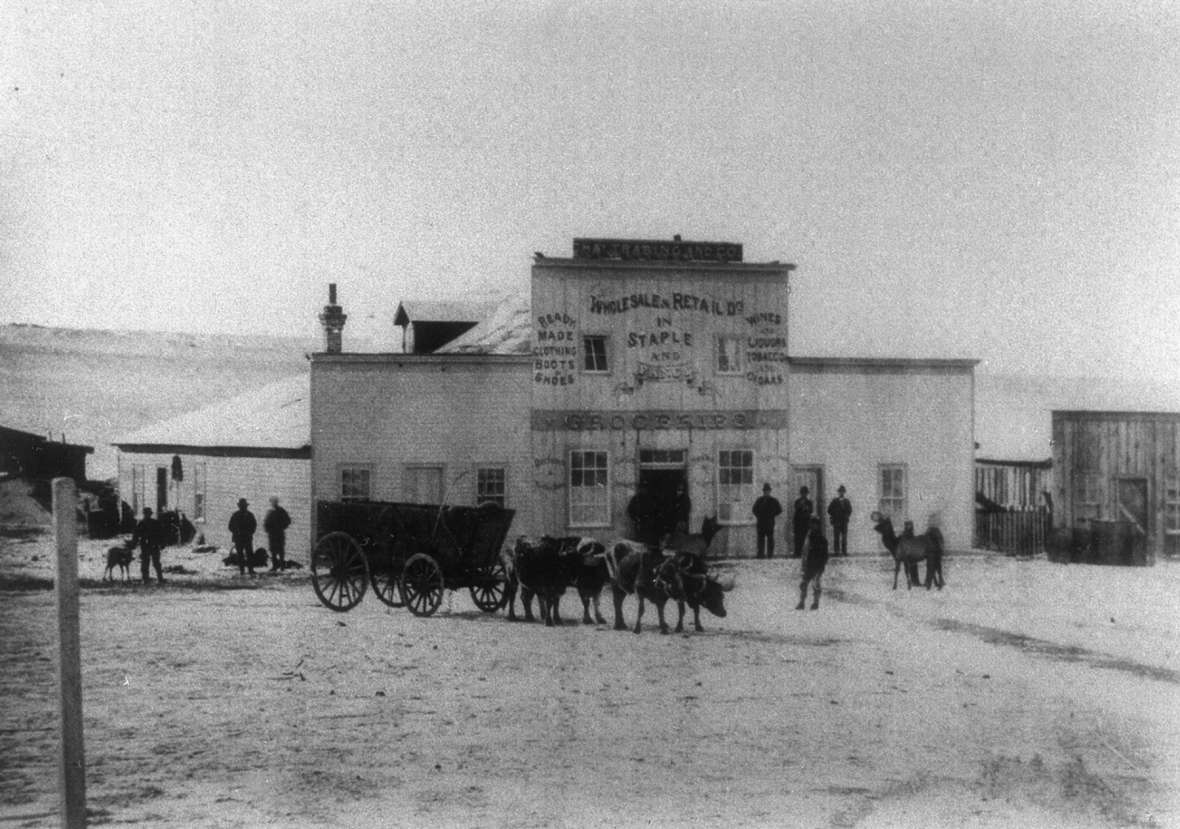
Army contracts
But war—and the military—would bring the brothers much bigger business. About this time, troops were being dispatched from Medicine Bow to Fort Fetterman and Cantonment Reno/Fort McKinney No. 1, near the Powder River crossing of the Bozeman Trail. This action started General Crook’s campaigns of 1876 to push the tribes onto reservations and open their land to settlers, beginning the most intense year of the Indian wars, later called the Great Sioux War.
The conflicts created more business for the Trabings and their freighters, who supplied the military forts and soldiers with tons of food, hay, cordwood, rifles and ammunition. Around that time, Trabing freighters were also hauling supplies to mining camps and settlers near Medicine Bow.
In early 1877, with the tribes subdued and northern parts of Wyoming Territory opened to white settlement, the Trabings decided they needed a permanent way station for their freighters along the Bozeman Trail. They chose the Crazy Woman Crossing on the old Bozeman Trail route for water, a change of horses and supplies halfway between Fort Reno to the south and the site of the former Fort Phil Kearny to the north, and a day’s ride from each.
In the Nov. 4, 1877, Cheyenne Daily Leader, the Trabings advertised their need for 50 teams to carry freight from Medicine Bow to forts Fetterman and Reno. They offered freighters $1.25 per 100 pounds from Medicine Bow to Fort Fetterman and $2.40 per 100 pounds from Medicine Bow to Fort Reno.
Many such ads ran in the Cheyenne and Laramie papers from 1874-1883, as Trabings needed many freighters to fill contracts to haul large loads to northern Wyoming. They employed 80 to 100 freighters at various times. August Trabing was frequently listed among the freight contractors present in Cheyenne at the Army’s Camp Carlin to bid for hauling immense amounts of military goods north.
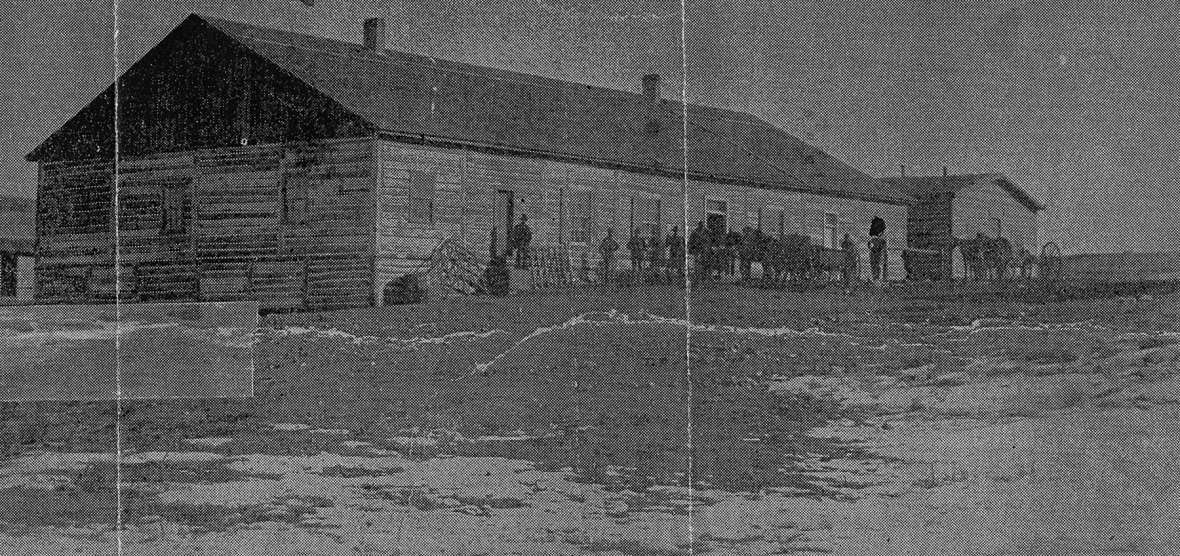
They expanded still more in 1877, remodeling and enlarging their Blue Front Store into a large wholesale and retail business. The grand opening was May 28, 1877. Three days later, a telegram informed them that thieves had broken into the Medicine Bow Store and robbed them of $2,000 to $3,000 worth of goods.
In January 1878, the Laramie Sentinel wrote that the Trabing freighting business was supplying more than three million pounds of government supplies to military posts north of Medicine Bow, and the firm was reported to have made more than $85,000 in sales the previous year, 1877—around $1.7 million today. Snow, high water and river crossing accidents continued to delay their freighting at times.
In early 1878 military reconnaissance reports concluded that Rock Creek Station, between Medicine Bow and Laramie, was a better shipping point to Fort Fetterman than Medicine Bow. A new freight warehouse and shipping depot were established there by other freighters. This threatened the Trabings’ monopoly on freight from Medicine Bow, so they built a road from Medicine Bow north to the North Platte River above the bridge at old Fort Casper. From there they headed down Salt Creek and the Powder River to the station near Fort Reno, now site of the first Fort McKinney, near the Bozeman Trail’s Powder River crossing. This saved 40 miles over the Fort Fetterman route and helped them compete in bidding for freighting contracts directly into the Powder River Basin.
Laramie newspapers reported that Trabing freighters were “shipping freight of the Second Cavalry to [the Powder River country] and has 75 teams employed and will shortly need 25 more.” During this time they were busy with the Blue Front Store in Laramie, their store in Medicine Bow, the TB ranch out of Medicine Bow and, by early 1878, with building a large store, blacksmith shop, telegraph station and post office at the Crazy Woman location.
That store, remote as it was, was robbed multiple times by outlaw gangs. After Fort McKinney moved to its second location, on Clear Creek near the future site of Buffalo, Trabings decided to build a store closer to the protection of that fort. They leased their Crazy Woman location to two families, Deacon and Walker, who later purchased that store. Because the boundary of the original military reservation around the fort allowed civilian establishments no closer than six miles, the place was called Six Mile ranch.
When the size of the reservation was reduced to where civilians could settle just two miles from the fort, the Trabings freighted their buildings piece by piece into what would become town of Buffalo, on Clear Creek, and built the first store in that location. A bill of lading from that time shows the three Trabing stores operating during that time, Laramie, Medicine Bow and “on Clear Creek near Ft. McKinney.”
They obtained large freight contracts from Rawlins, where they had leased the old courthouse as a warehouse, north to Fort Washakie and south to White River in Colorado. During 1880 one such contract was sublet to J. W. Hugus and Company of Rawlins, which failed to fulfill its contract due to weather. In November 1883, the U.S. government sued August and Charles Trabing for $76,000 for the failure. The jury ruled in favor of the Trabing Brothers. Headlines read, “Uncle Sam Beaten.” Other contracts during this period included hauling mining supplies to North Park, Colo., Cummins City (later Jelm), W.T., Douglas Creek in southern Carbon County and other locations.
Further details of Trabing Brothers accomplishments in the settling of Carbon, Johnson and Albany counties could fill a book. They were remarkable businessmen filled with energy and foresight. When Laramie city officials courted them to bring all of their business interests to that city, they reduced their obligations in the north and began selling their far-flung assets: the Medicine Bow store to J. W. Hugus in 1880 and the Buffalo store to J. H. Conrad on March 8, 1882. They concluded the sale of the TB ranch and other assets in Carbon County on Sept. 22, 1883. They built their residences and consolidated their business empire in Laramie during the next 25 years—another story.
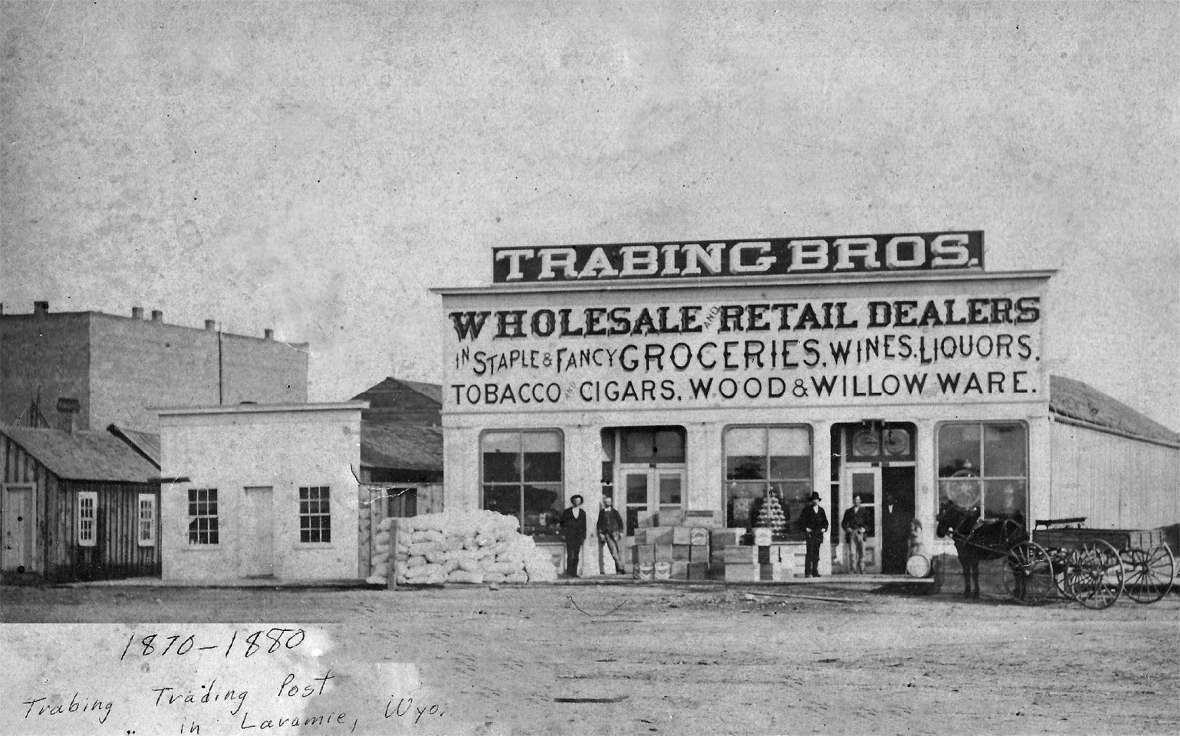
Resources
Primary sources
- Albany County Records, Office of the County Clerk, Laramie, Wyoming, Deeds Book A., pp 81 and 86.
- Albany County Records, Office of the County Clerk, Laramie, Wyoming, Miscellaneous Book A, p. 8.
- Augustus Trabing vs. The United States et. al. Indian Depredations claim no. 1432 , U.S. Court of Claims, 32 Ct. Cl. 440; 1897 U.S. Ct. Cl. Lexis 33, June 14, 1897.
- Cheyenne Daily Leader. “Wanted Immediately.” No. 41, Nov. 4, 1877, p. 4, col. 4.
- Cheyenne Daily Sun. “The Robbery of Trabing’s Ranch.” No.188, October 14, 1878, p. 2, col. 5.
- Cheyenne Weekly Leader. No. 14 Dec. 26, 1878, p. 8, col. 3. “Capture of a Band of Outlaws.”
- Frontier Index. July 21, 1868, p. 3, col. 2.
- Laramie Daily Sentinel. “Robbed Again.” No. 183, Dec. 2, 1878, p. 4, col. 2.
- Laramie Daily Sun. “From Medicine Bow.” No.77, March 26, 1875, p. 3, col. 3.
- Laramie Weekly Boomerang. “Uncle Sam Beaten.” No. 36 Nov. 15, 1883, p. 3, col. 1.
- Laramie Weekly Sentinel. “A New Route.” No, 39, Feb. 11, 1878, p. 4, col. 4; “Routes from the Railroad to Fort Fetterman.” No.183, Dec. 2, 1878, p. 4, col. 2; “Teams Wanted.” No. 4, May 22, 1880, col. 4; “. . .36 teams wanted to freight to North Park and Cummins City Mine . . .”No. 27, Oct. 30, 1880, p. 3; “Trabing Block,” Dec. 1, 1883, p. 1, cols. 1-4;
- Trabing Family Collection
Secondary sources
- Baker, Lillian. “Progress of Buffalo since Its First Store Traced by Early Pioneer.” Buffalo Bulletin, Aug. 9, 1951.
- Beery, Gladys B. Sinners & Saints, Tales of Old Laramie City. Glendo, Wyo.: High Plains Press, 1994, 63-68, 99-101, 157-160.
- _____________. The front streets of Laramie City. Laramie, Wyo: Albany Seniors, Inc., 1990, 27-167 .
- Bollinger, G. A. The Occidental, 1879 to 2009: an historic Wyoming hotel. Buffalo, Wyo: Jim Gatchell Memorial Museum Press, 2011, 10-11.
- Carter, Charles Hanna, ed. “ AN OLD-TIMER’S STORY OF THE OLD WILD WEST, Being the Recollections of Oliver Perry Hanna. Compiled 1926. Casper, Wyo.: Endeavor Books, 1986, 61-66.
- “Gus Trabing Rugged Merchant who Pioneered First Store in This Area.” Buffalo Bulletin, Aug. 16 1962.
- Hanson, Margaret Brock. Frank Grouard, Army Scout. Kaycee, Wyo.: published by author, 1983, 166-172, 184.
- ___________________, ed. Powder River Country, the Papers of J. Elmer Brock. Kaycee, Wyo.: 1981, published by the editor, pp, 163, 166, 175, 176.
- “Lawless Elements Brazen in 1878. Road Agents Traveled Along Bozeman Trail Plundering Travelers and Stores.” Buffalo Bulletin, July 4, 1963.
- Miller, Mark. Military Sites in Wyoming, 1700-1920: Historic Context. Laramie, Wyo. : Wyoming Dept. of State Parks & Cultural Resources, 2012.
- Murray, Bob. “Mysteries by the Wayside: Trabing.” Country Journal, Aug. 6, 1980.
- Murray, Robert, Cultural Resource (Historic) Inventory of the Casper District of Wyoming: Technical Appendices and Bibliography, Vol. II, Sheridan, Wyoming, Inc., February, 1978.
- Pence, Mary Lou. Boswell, The Story Of A Frontier Lawman. Cheyenne, Wyo.: Pioneer Printing & Stationary Co., 1978.
- Smith, Omie. Trabing—Wyoming Territory. Buffalo, Wyo.: Johnson County Library, 1958.
- “Starting Settlement—Trabing.” Frontier City Argus, Byron, Ohio, May 29, 1879.
- Wall, J. Tom. Crossing Old Trails to New in North Central Wyoming. Philadelphia: Dorrance & Company, 1973. 6-9, 13, 27.
Illustrations
- The A.J. Russell photo of the freighters waiting for the supply train at the end of tracks is from the online Russell collections at the Oakland Museum of California. Used with thanks.
- The rest of the photos are from the author’s collection of Trabing family photos. Used with permission and thanks. The photo of the log store in early Buffalo is reproduced from the Buffalo Bulletin of August 9, 1951. Used here with thanks. The accompanying article claims the photo is the oldest surviving photo from Pease County, before it was renamed Johnson County.
